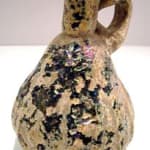Early Islamic Glass Vessel, 600 CE - 800 CE
Glass
3.125 x 4.75
X.0638
Further images
The advent of Islam in the seventh century and the empire created by its adherents had little immediate impact on glass production. In the Eastern Mediterranean Classical-Byzantine forms and techniques...
The advent of Islam in the seventh century and the empire created by its adherents had little immediate impact on glass production. In the Eastern Mediterranean Classical-Byzantine forms and techniques continued to be practiced, whilst further east Parthian-Sassanian traditions prevailed. By the late eighth century however it is possible to discern a distinctively 'Islamic' style of glass. Cultural ties across the empire and the migration of craftsmen from one area to another helped to fuse Classical and Near-Eastern traditions. Whilst it is certainly true that one of the characteristic features of Islamic glass is the emphasis on decoration, undecorated vessels of great beauty were also created. Many of these were used for everyday purposes by the urban population- as tableware, containers for oils and perfumes, storage vessels, oil lamps and even for scientific and medicinal equipment.
Although weathering due to burial often prevents a full appreciation of the chromatic as well as the sculptural appeal of a glass vessel, many have survived in excellent condition and still convey a playful charm. Globular bottles and vases, small flasks and ewers were the favoured shapes during the Islamic period. The decorative elements often took on regular circular forms (discs, roundels, ovals, prunts). The majority of such vessels were decorated with applied glass of the same colour since the shape and distribution on the surface would be sufficient to emphasize the ornamental pattern.
This thick vessel has a flat base, flared walls, a applied handle and a conical shaped body. Throughout the centuries, the surface has been partially weathered, resulting in the formation of a white patina and iridescence, giving the object a magnificent tint.
Such decorated vessels were once dated exclusively to the pre-Islamic period. However, a dating to the proto-Islamic period (7th -8th century) seems more appropriate, since these objects do not have an immediate parallel with known late Roman pieces. On the other hand they were certainly produced before the codification of shapes and decorative patterns that occurred in the 9th century.
Although weathering due to burial often prevents a full appreciation of the chromatic as well as the sculptural appeal of a glass vessel, many have survived in excellent condition and still convey a playful charm. Globular bottles and vases, small flasks and ewers were the favoured shapes during the Islamic period. The decorative elements often took on regular circular forms (discs, roundels, ovals, prunts). The majority of such vessels were decorated with applied glass of the same colour since the shape and distribution on the surface would be sufficient to emphasize the ornamental pattern.
This thick vessel has a flat base, flared walls, a applied handle and a conical shaped body. Throughout the centuries, the surface has been partially weathered, resulting in the formation of a white patina and iridescence, giving the object a magnificent tint.
Such decorated vessels were once dated exclusively to the pre-Islamic period. However, a dating to the proto-Islamic period (7th -8th century) seems more appropriate, since these objects do not have an immediate parallel with known late Roman pieces. On the other hand they were certainly produced before the codification of shapes and decorative patterns that occurred in the 9th century.





